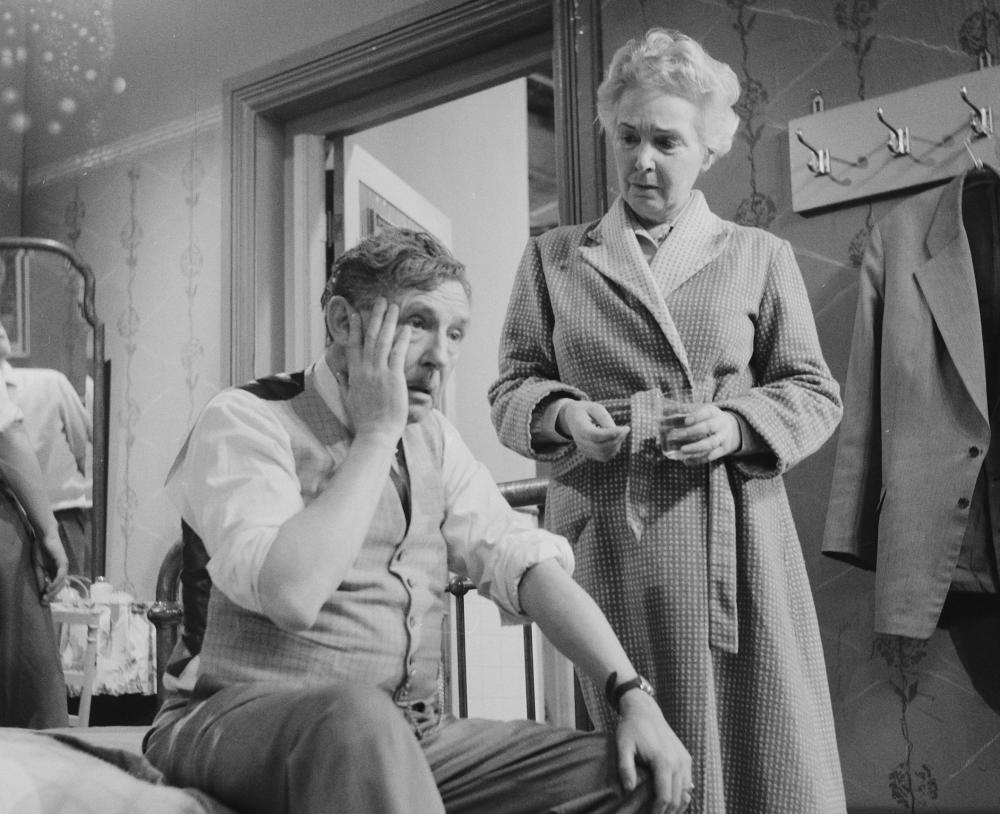Books & Culture
Move Over, Willy Loman—Literature Needs a New Salesman
The salesman has long represented the American Dream. It's time to broaden our imagination about what that looks like.

I remember feeling as if I was about to vomit. Sitting smack dab in the middle of an office—open layout, of course, as this was a startup—my foot tapping the hardwood floor, eyes clenched, hand gripping the hard, black plastic phone in my hand as it rang, rang, and rang. Silence pervading the office, momentarily punctuated by one of the other twenty-something people in the room clearing their throat, a stray sneeze, or hiccup. Me praying to every deity known to man for the stranger I was calling to not pick up. Then, eventually, hearing “hello?” The deities must’ve taken a day off.
My first sales call was atrocious. I was tasked with cold calling business owners in New Jersey to tell them about a local newspaper recently featuring the organization I worked for. The idea was that I would call these business owners, tell them about the story on us, and then somehow interest them in purchasing subscriptions to our service. The only problem was that I had no idea what I was doing, resulting in prospects laughing at me, putting me on speaker so that I could flounder to the entertainment of their colleagues, and, most egregiously, no deals.
Fortunately, this didn’t go on for too long. With the help of the organization’s co-founders, a healthy dose of fear, and a do-or-die mentality, I improved, closing $500 and $1,000 deals before moving to sales development—a specialized role where reps qualify inbound and outbound prospects—which was more in line with my skill set as a green 22-year-old. Within two years I was managing a team of 30 reps, the company had grown to over 200 people, and the sales team evolved from me trying not to wet my pants to a highly-disciplined, relentless, and inspiring group of people who knew no limits.
Disillusioned with the world of startups and sales, I focused on reinventing myself as ‘Mateo, the writer.’
In 2016, I left. Disillusioned with the world of startups and sales, I focused on reinventing myself as “Mateo, the writer.” After writing—but, ironically, not being able to sell agents on—two novels, I was at a loss. Fortunately, I was always reading. And at that point of desperation, I had Stephen King’s On Writing in my hands—cliche, I know, but true. Aside from King’s simple advice of writing and reading more to improve your skills as a writer, what resonated most with me was when he wrote that all he does to begin his 50+ novels is, “Put interesting characters in difficult situations and write to find out what happens.”
FLASH! BOOM! POP! The fireworks went off in my head. I felt foolish for not having thought of it sooner. From my years in the tech sales industry, as one Black man out of the few Black people I’d ever encountered in the same role, I had a unique perspective that afforded me the ability to create interesting characters and complex, difficult situations for them, which I’d then have to get them out of, or not. This realization—mixed, candidly, with a heavy sense of guilt that I could and should have done more to bring other people of color, especially Black people, into this niche industry I had gained privileged access to—planted the seed of a story that needed to be told, not only for myself, or for the other minorities trying to survive in white-dominated workplaces, but for those who have never even heard of things like Sales Development Representatives (SDRs), Annual Recurring Revenue (ARR), BANT, Marketing Qualified Leads (MQLs), Sales Qualified Leads (SQLs), and a myriad of other almost nonsensical startup sales jargon. Through illustrating the meteoric rise and earth-shattering fall of Darren “Buck” Vender, a Black salesman at an all-white New York City tech startup who hatches a plan to help other people of color infiltrate America’s sales forces, I would redefine the model of the American salesman, in reality and literature, simultaneously giving people of color the skills and knowledge necessary to enter the same world I had come from, if they desired.
But in order to achieve this goal of redefining the American salesman, I needed to better understand the place that salesmen, both real and imagined, occupy in the American subconscious. And before there was ever a Wolf of Wall Street (2013), Boiler Room (2000), Glengarry Glen Ross (1992), Tin Men (1987), Wall Street (1987) or even The Pursuit of Happyness (2006), which likely did more to warm viewers’ hearts than really reengineer their perception of salesmen, there was Arthur Miller’s Pulitzer and Tony Award-winning play, Death of a Salesman (1949). And without Death of a Salesman, featuring Willy Loman, America’s most memorable salesman of the twentieth century, there is no Buck Vender, because for literature to need a new salesman, there has to be the salesman, and Willy Loman was it.
For literature to need a new salesman, there has to be the salesman, and Willy Loman was it.
Appearing in 1949, Willy Loman embodied all that it meant to be an ideal American at the time: white, male, hard-working, and forever clutching at the well-advertised American aesthetic of being able to turn lead into gold through sheer will and being well-liked.
As far as salesman go, Willy, despite believing himself to be more charming and successful than he is, is painfully sub-par. Miller, in an attempt to render Willy as a mirror-like John Doe any disgruntled white male could see himself in, never mentions exactly what Willy sells, or is supposed to sell. All we know is that he’s aging, down on his luck, and has an adoring wife he takes for granted and two sons, Biff and Happy, onto whom he tries to imprint his illusions of grandeur. In this, Willy Loman is unparalleled. Through a maniacal range of mental machinations, Willy has the ability to distort his own perception of reality, as well as that of his family, allowing him to frequently make life appear shinier than it is, or ever will be. “Be liked and you will never want,” Willy tells his sons. “You take me, for instance. I never have to wait in line to see a buyer. ‘Willy Loman is here!’ That’s all they have to know, and I go right through.”
The unfortunate fact is that Willy, acting as Miller’s everyman, was purely a reflection of the door-to-door salesmen, and hard-working Americans, in general, of the time. For those living in the white picket fence, apple pie, Coca-Cola version of 20th-century Americana, white men in suits bearing briefcases containing samples, Hoover vacuums, or even overpriced Bibles knocking at their doors was no strange occurrence.
In the 1969 documentary Salesman, brothers Albert and David Maysles, along with co-director Charlotte Zwerin, follow four Bible salesman around America. Paul Brennan, an older employee of the Mid-American Bible Company, can be seen lamenting his lack of sales one moment, while drumming on his steering wheel and singing tunes of prosperity the next. Like Willy, Paul believes all he needs to do to turn his luck around is buckle down.
While 20th-century salesmen like Willy, Paul, and others bolstered their confidence by reconstructing the world around them in a way that often made them both hero and victim, one of the chief reasons that they were able to willfully believe they could sell to anyone was that buyers – whether unsuspecting housewives or advertisers looking to get an edge – often operated at an informational disadvantage. In his book, To Sell is Human, Daniel Pink describes the theory of information asymmetry, where “one side is fully informed; the other is at least partially in the dark.” The example he gives is that of a used car salesman: “Bad cars, what Americans call ‘lemons,’ are obviously less desirable and therefore ought to be cheaper. Trouble is, with used cars, only the seller knows whether the vehicle is a lemon or a peach.”
The stereotypical salesperson—loud, arrogant, flashy, male, and white—is still very much embedded in the American psyche.
But this information asymmetry doesn’t exist today in the same way it did for much of American history up until the late 20th century. With enforced safeguards, like warranties and terms of conditions, paired with the rise of the internet, where people can quickly Google product information, comparisons, and reviews, the salesman of the 21st century has had to adapt. And while it is still possible for modern-day Willy Lomans to exist and multiply in the breeding grounds of Wolf of Wall Street-esque boys clubs and boiler rooms, society is less forgiving.
Despite these changes in the world of sales and consumerism, the stereotypical salesperson—loud, arrogant, flashy, male, and white—is still very much embedded in the American psyche. The sex, cocaine, and money-fueled life of Jordan Belfort, as depicted in Martin Scorsese’s Wolf of Wall Street (2013), which grossed $392 million worldwide, was nominated for five Oscars, and ranked by the BBC as seventy-eighth on its list of the “100 Greatest Films of the 21st Century.” And before that there was Wall Street, for which Michael Douglas won an Oscar for Best Actor, and before that there was Glengarry Glenn Ross, the film, for which Al Pacino was nominated an Oscar and Golden Globe, for Best Supporting Actor, and before that there was Glengarry Glenn Ross, the play, which won a Pulitzer in 1983. All of this makes the goals of my novel-in-progress highly ambitious, and potentially foolhardy, but not impossible.
And it is in this context, of an America that, while regressing in some ways, is also having its ideals, models, and standards upended daily, I realize writing about a Black salesman is a responsibility I’ve undertaken and must respect. He is human. He makes mistakes. He falls into many of the same traps of material gain and fame that the salesmen I am looking to supplant glorified, but he is also the calling of a new day where his story, while being fiction, will mirror and amplify the realities that minorities striving to make space for themselves, and others like them, in the workplace know too well, regardless of if they’re lawyers, doctors, engineers, editors, entertainers, or educators.
These men are relics of what America was rather than what it is becoming, or what we might want it to be.
Boots Riley’s 2018 sci-fi film, Sorry to Bother You, succeeded in some of this, but the film is too fantastical—and its protagonist, Cassius Green, too ultimately skeptical of the world of sales—to overwrite our image of the salesman as a middle-aged white guy. If you ask Americans “Who’s the most well-known American salesman to ever grace the pages of literature or movie screens?” they’ll still think of Willy Loman, or maybe Jordan Belfort and his ilk. But this is short-sighted. These men are relics of what America was rather than what it is becoming, or what we might want it to be. While our American organizations are still disproportionately white, there are minorities of all kinds, like myself, who do not see themselves reflected in Leonardo DiCaprio’s blue eyes. And our stories must be told.
It is because of this disparity between the reality we experience and the words we read on the page that literature is sorely in need of a new salesman to root for, and, at times, hate. We are starting to recognize that the Everyman can’t be only one type of man: the white middle-class middle-aged sap, the white middle-class middle-aged shark. If the salesman is the avatar of the American dream, he—or she—can’t just be a Willy Loman. In my novel-in-progress, just as in reality, there are salesmen and saleswomen of color, gay and bi salespeople, salespeople born with silver spoons in their mouths and salespeople who still struggle to get the taste of dirt out. Because in the same way that Miller’s salesman’s failures contained a mirrored truth for white men and women of the 20th century, my salesman’s hopes for a world where people of color, and other minorities, don’t have to scream to be heard or fight to be felt embody the dreams of those in our time who understand “diversity” is only a performative buzzword online and in the workplace until people begin hacking, with an unrestrained aggression, at the roots from which our nation continues to grow.








